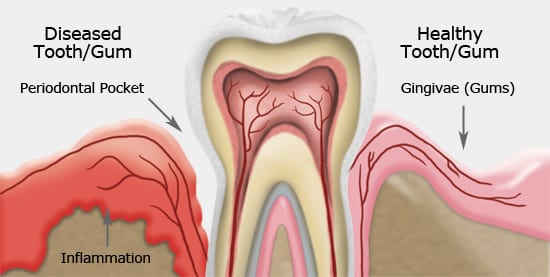Most of us can grasp the idea of tooth decay, but we often forget that the gums supporting the teeth can also get infected and be of equal importance to our dental health. Gum or periodontal disease is mainly the result of infections and inflammation of the gums and bone that surround and support the teeth. In its early stage, called gingivitis, the gums can become swollen and red, and they may bleed. In its more serious form, called periodontitis, the gums can pull away from the tooth, bone can irreversibly be lost, and the teeth may loosen or even fall out.
Gum disease, like a dental cavity, is caused by bacteria. Did you know significant associations between periodontal disease and cardiovascular disease, diabetes mellitus, preterm low birth weight, and osteoporosis have been discovered? The links among oral diseases and systemic diseases are serious and physicians and dentists are teaming up, more than ever, to treat the body as a whole.
As a dentist in Sacramento, I strongly encourage all of my patients to be aware of the health of their gums. The consequences of neglecting them can be devastating.

Gum Disease Risk Factors
- Diabetes – People with diabetes are at higher risk for developing infections, including gum disease.
- Other illnesses – Diseases like cancer or AIDS and their treatments can also negatively affect the health of gums.
- Smoking – as if you needed another reason to quit smoking!
- Hormonal Changes in girls/women including pregnancy
- Medications – some medications can actually contribute to gum disease or cause dry mouth
- Genetic Susceptibility – some people are more genetically susceptible to developing gum disease
Treatment Options
TREATMENT | What is it? | Why is it used? | How is it used? |
Prescription antimicrobial mouthrinse | A prescription mouthrinse containing an antimicrobial called chlorhexidine | To control bacteria when treating gingivitis and after gum surgery | It’s used like a regular mouthwash. |
Antibiotic microspheres | Tiny, round particles that contain the antibiotic minocycline | To control bacteria and reduce the size of periodontal pockets | The dentist or hygienist puts the microspheres into the pockets after scaling and root planing. The particles release minocycline slowly over time. |
Oral antibiotics | Antibiotic tablets or capsules | For the short term treatment of an acute or locally persistent periodontal infection | These come as tablets or capsules and are taken by mouth. |
Deep Cleaning (Scaling and Root Planing) | A cleaning that will get to the base of a deeper periodontal pocket. Effectively treats 4-5 mm pockets. Can be used to treat 6-7 mm pockets in some instances. | To reduce periodontal pocket depths to create a more healthy and cleansable environment. | The hygienist will be performing this procedure with traditional anesthetic or topical anesthetics. Routine follow up and home care is important for treatment success. |
Laser-Assisted Periodontal Therapy | A diode laser that is used at a specific setting to target pigmented, anaerobic bacteria that cause gum disease. | Lasers can help significantly reduce bacteria in an unhealthy periodontal pocket. In addition, it can help reduce bleeding and discomfort following a deep cleaning. | The laser tip is placed under the gum line. It can be combined with your deep cleaning appointment and subsequent cleaning appointments, only takes 10-20 minutes, and does not cause any additional discomfort. |
Gum Surgery | Surgery might be necessary if inflammation and deep pockets remain following other treatment methods. This procedure would be reserved for pockets greater than 6mm and would require a referral to the periodontist who is a gum specialist. | After surgery the gums will heal and fit more tightly around the tooth. This sometimes results in the teeth appearing longer. But ultimately, the teeth can be maintained and stop the progression of gum disease and tooth loss. | This surgery involves lifting back the gums and removing the tartar. The gums are then sutured back in place so that the tissue fits snugly around the tooth again. |
OK, OK, Dr. Apekian, we get it…GUMS are important, but now what?
Well, first thing is first. Make sure you are getting your annual exams and cleanings. Once a year at Midtown Dental, we check the health of your gums and give you you specific recommendations. Even healthy gums require maintenance at least every 6 months with a routine cleaning. I am personally very proactive with periodontal disease, because sadly, once you’ve lost bone, it’s gone for good and very unlikely to be restored. PREVENTION is key, so schedule your appointment today. It’s good for your smile AND your overall health!
References:
www.nidcr.nih.gov/oralhealth/topics/gumdiseases/periodontalgumdisease.htm
Call today at (916) 441–5800 to learn more about our dental services.
